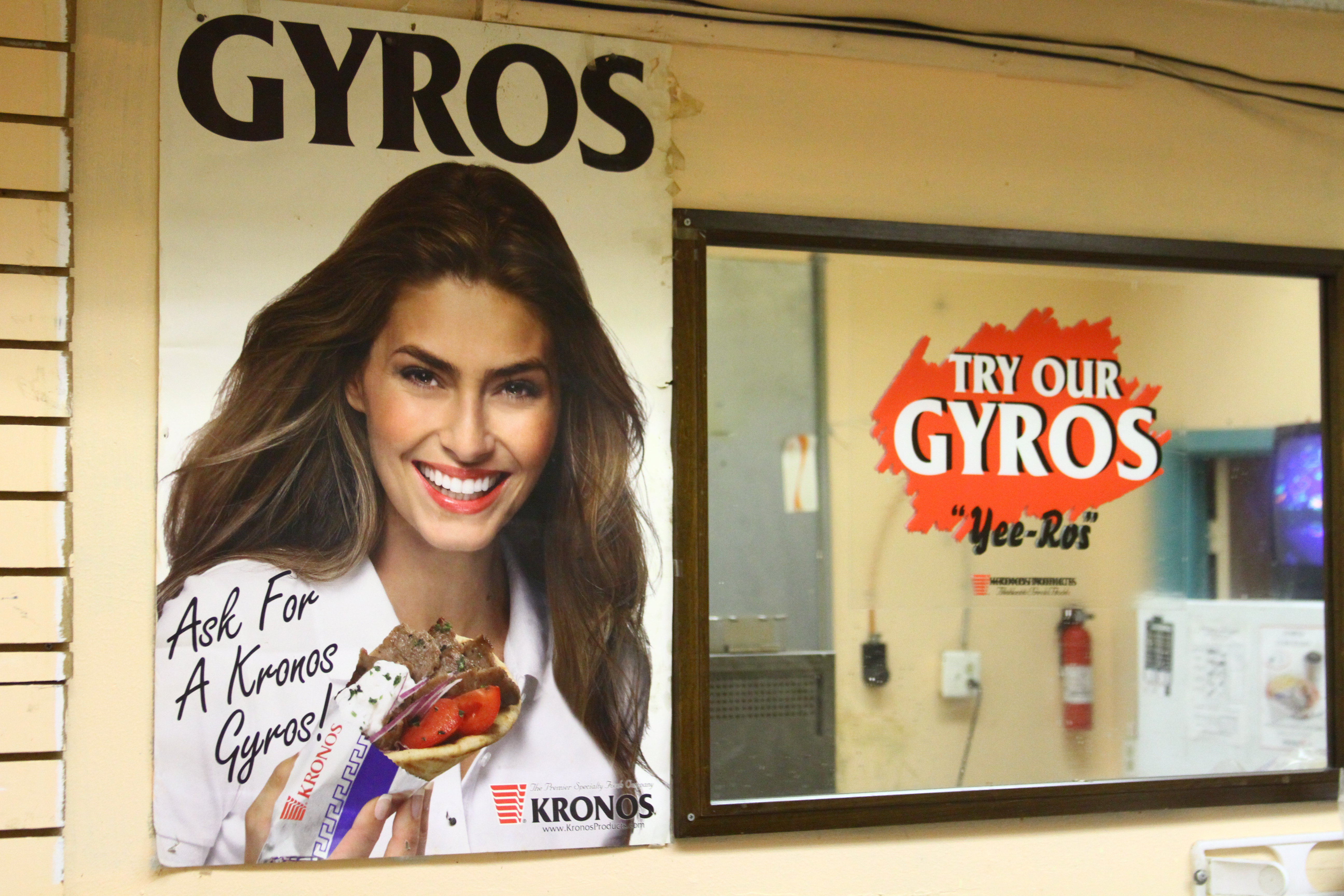From Greek joints in Chicago to delis in L.A., you’ve seen her. Sometimes she’s blonde, sometimes brunette, but she’s always smiling. And holding a gyro.
I’ve long been intrigued by this series of posters, a decades-old ad campaign featuring exotic beauties wielding gloppy Greek tacos and a look that seems to say, “I know something you don’t.” My fascination has less to do with the women featured—though there is a certain mystery to them—than with their near-ubiquity in casual gyro cafes across the nation.
I’m not the only one, it seems. A number of personal blogs have sounded off on the topic, dubbing the woman the “Marlboro Man of the gyro industry” (johnlarroquetteproject.com) and waxing philosophical over the ad’s message and “the real mechanism of the gyro’s appeal” (todayyourhairisverynice.blogspot.com).
Unfailingly stamped with some variation of the message “Try a Kronos gyro!”, the posters are the brainchild of Kronos Foods Inc., a Chicago-based Mediterranean-food distributor that popularized the gyro as we know it today. Founded in 1975, when the sandwich was relatively unknown, it was the proprietary Kronos gyro “cone”—that spindle of processed meat carved to order—that swiftly standardized the product. After that, as best as I can tell, came this ad blitz.
But reaching out to Kronos for more answers about the poster’s history and culture did little to help—no one responded to my phone or e-mail inquiries. The only real tip I had to work from was a quote from a 2005 article in Crain’s Chicago Business, in which Kronos founder Chris Tomaras weighs in briefly on the matter. He picked the first—blonde—Kronos poster model. “The idea was to not have a Greek-looking girl, but an American girl,” he said. “And it worked. It worked by Americanizing the product.”
OK, I get it. The best image to market an unfamiliar food is hardly a hairy Greek restaurateur. But that’s no mystery solved, to me. The gyro lady has endured multiple makeovers into the 21st century. The ’70s and ’80s brought the original blonde babe—and possible John Hughes movie extra—but today’s gyro gal is an olive-toned Cindy Crawford-esque model (both pictured). Somewhere in between a more archetypally Greek-looking woman joined the party, a move that perhaps signaled the cultural acceptance of the gyro into the American diet (i.e., the “un-Americanizing” of the product). Yet for reasons unknown, these models have had no lack of restaurant wall space upon which to shamelessly hawk their wares.
At Mediterranean Mix (205 First Ave. S., 341-9265), in fact, there’s two, one below the register and one on the opposite wall (though partially obscured by a Sounders banner). I order some baklava and ask my cashier, Jude, about them. “I don’t know,” she says. “I’ve been here for two years, and they’ve been here at least that long.” She goes on to wager they’ve been part of the decor since the restaurant opened, in “about 1998 or 1999,” she says. “It’s funny,” she says, handing over dessert. “Now I’m going to start noticing them.”
At Dino’s Gyros (126 S.W. 148th St., Burien, 838-8620), under Gyro Lady’s approving countenance, my husband inquired about the poster with Anna after she took our falafel order. “I’m not sure about that,” she said. “All I know is that it looks kinda ’80s, and it’s in practically every gyro shop there is.”
Fair enough. But Anna’s thoughts on the subject—she’s aware of her presence but never really considered it much—got me thinking. Perhaps that’s the genius of this poster campaign. After all, isn’t the most effective brand the subliminal kind—the kind that makes you think it’s your own hunger that desires a gyro, when it’s actually the brand that desires you?
That would be the last glimmer of insight in my investigation, as Jude’s and Anna’s comments set me on a trajectory that ultimately did not pan out. I hang up my gumshoes at Main Street Gyros (301 Second Ave. S., 335-7940) when I check in with Hamza, whom I know from the neighborhood. The poster hung just below the register until a recent kitchen fire prompted a large renovation and it was removed.
“Yes, I know it,” Hamza says. He too thinks the model isn’t American. “She’s Greek, for sure,” he says, then offers to get me a poster.
When I explain that I’m actually looking for information about it, he tells me he’ll ask his supplier for me, and ushers me outside when he makes the call. When he hangs up, though I make no attempt to hide my wedding ring, he says, “I have to tell you, I do want to date you, but I have a girlfriend.”
Way to let me down easy. I text him later: “Anything from your supplier?”
“Not yet,” comes the reply.
I stop in the next Monday. “Any news?”
“He says he’s going to get back to me Thursday,” Hamza says.
I ask about the poster, still nowhere to be seen. “Doesn’t Kronos require you post it?”
“No,” he says. “Our food is so good here, we don’t need a poster to tell you that.”
Touche, Hamza. With that, I’m content to let the mystery be. Like some Mona Lisa of casual Greek cuisine, the omnipresent Gyro Gal has a story to tell somewhere within that smug, secretive expression of hers. It’s something to think about, anyhow, when you suddenly feel her eyes upon you the next time you go out for Greek.
gelliott@seattleweekly.com








